There's No Place Like Sunnyslope
By Marshall Shore
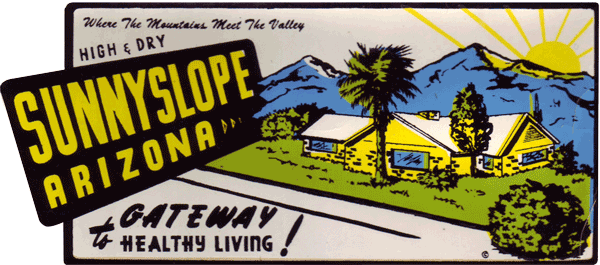
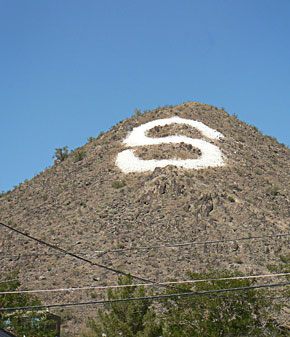
S Mountain
One of the most visible land marks viewable on a clear day from thirty miles is “S” mountain located near Central Avenue and Hatcher. Since the early 1950’s the freshman class at Sunnyslope High School has made an annual trek up the mountain delivering a fresh coat of white paint to the upper case “S.”
William R. Norton is considered to be the founder of Sunnyslope. Mr. Norton homesteaded many acres of desert land around the turn of the century; in 1911, he platted Sunny Slope Subdivision, the first subdivision in Sunnyslope.
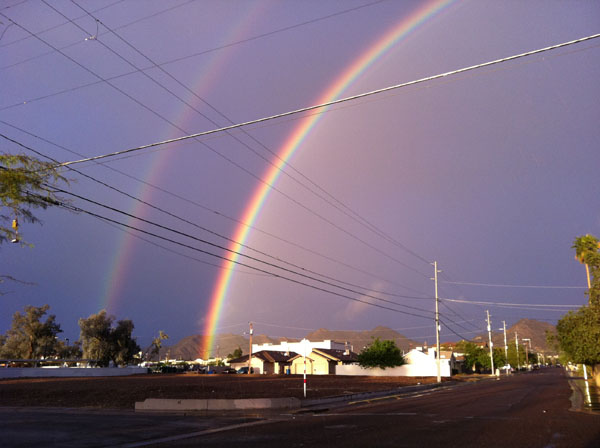
April 9, 2011: on
the occasion of a freakish April shower during Modern Phoenix Week,
a double rainbow appeared over Norton's Sunny Slope subdivision near 3rd Street and Alice Avenue.
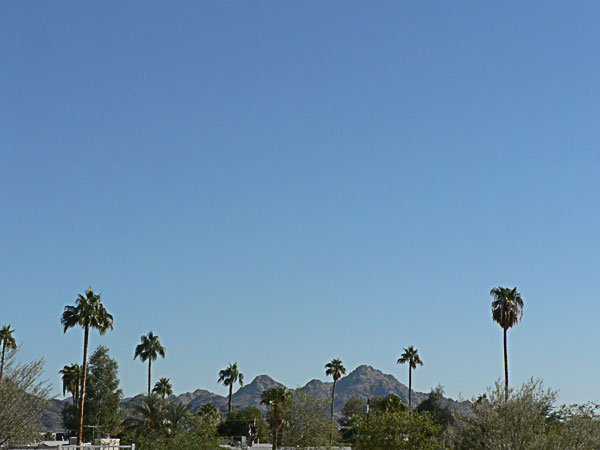
Clear skies and the famously sunny slope
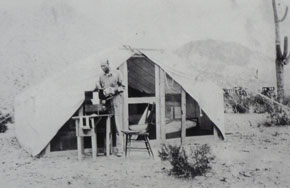
Desert tent
This new desert frontier was a booming land of promise, not only for the healthy but also for the sick. Arizona's sunshine and arid climate drew many people suffering from tuberculosis, rheumatism, asthma and various other diseases. Many of these people moving to Sunnyslope built tent houses or small cottages, planning to get well and then return to their old homes. Some people, however, liked the desert and decided to remain.
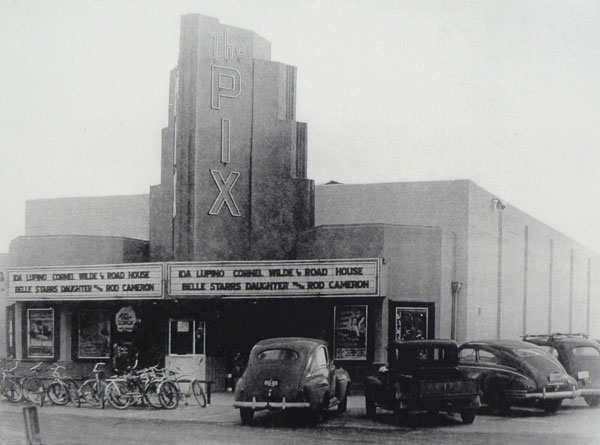
The old Pix Theater
One such Valley resident was John C. Lincoln, an Ohio inventor and industrialist who founded Lincoln Electric. He relocated to Paradise Valley with his wife Helen to treat her tuberculosis. Almost immediately, the Lincolns became major financial supporters of Desert Mission. The Desert Mission was a faith-based medical service provider that included a food pantry, child care and library, and eventually evolved into John C. Lincoln Health Network. Helen Lincoln lived to the age of 102, after initially being given just two more years to live by doctors at the age of 40.
Others relocated to pursue their dreams to build new lives and futures for their families. The small Sunnyslope community grew to include among its residents prospectors, homesteaders, beekeepers, and various other creatives. Arizona's open space and weather made it an ideal training ground for servicemen, and many of them returned to the area following World War II fueling Arizona's growth.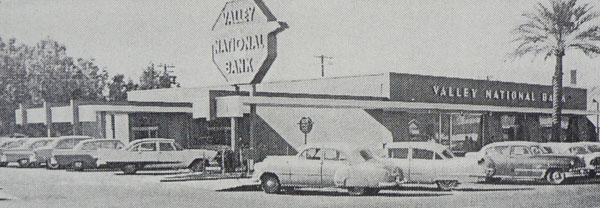
Others relocated to pursue their dreams to build new lives and futures for their families. The small Sunnyslope community grew to include among its residents prospectors, homesteaders, beekeepers, and various other creatives. Arizona's open space and weather made it an ideal training ground for servicemen, and many of them returned to the area following World War II fueling Arizona's growth.

Valley National Bank played a crucial role in home and business financing

The vintage Eye Opener cafe received exterior rehabilitation assistance in 2011
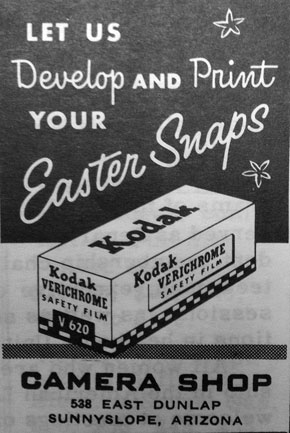
Small business advertisement near Central and Dunlap
The Sunnyslope transformation began with Sunland, a subdivision laid out with curved streets and more than seventy homes with two and three bedrooms, by local prominent architect Leslie Mahoney. Former newspaper publisher turned developer and builder W.D. Upshaw created five subdivisions in Sunnyslope between the years of 1945-55. In 1947 he held the largest residential developments in the state.
Recognizing that the residential growth made local retail more economically viable and desirable, Upshaw constructed two business blocks at Central and Hatcher. Upshaw homes were built of increasing size to appeal to Easterners already used to larger homes. This established Sunnyslope as a solid middle class suburb.

A curved masonry wall in El Domingo Ranchos home is
a hallmark of Hart Homes designed by George N. Richards
The financing was pulled together to build one residential home, which sold quickly. This led to additional homes being built in that subdivision, as well as the development of several small subdivisions through out the valley, one of which was El Domingo Ranchos located at 12th Street and Manzanita.
Hart’s involvement in groups such as the Lions Club, the Masons, and the Shriners led him to be elected to the Maricopa County Board of Supervisors. A car accident in 1960 brought his civic contributions to an early demise.
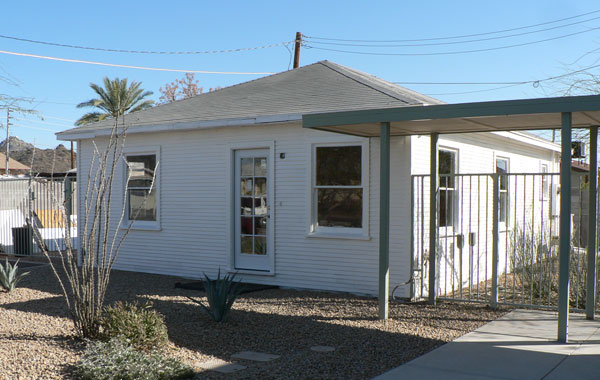
The Inskeep Residence in 2011
Many residents built their own homes. Walter Lovinggood built his own, then developed the land next door on speculation 1945. In 1947 he found the perfect new owners, Corda and Oliver Inskeep, a couple in search of recuperation from cancer and debilitating headaches. Mrs. Inskeep lived there for most of her life. When a shopping center threatened to replace the property a few years ago, the Inskeep house was uprooted and moved to the grounds of the Sunny slope Historical Society Museum. It is now undergoing tip-to-tail transformation to become an exhibit of a rare postwar home style that was once a common type throughout the community. Every detail down to the silverware and toothpaste will contribute to the complete time capsule demonstrating] ideal postwar living.
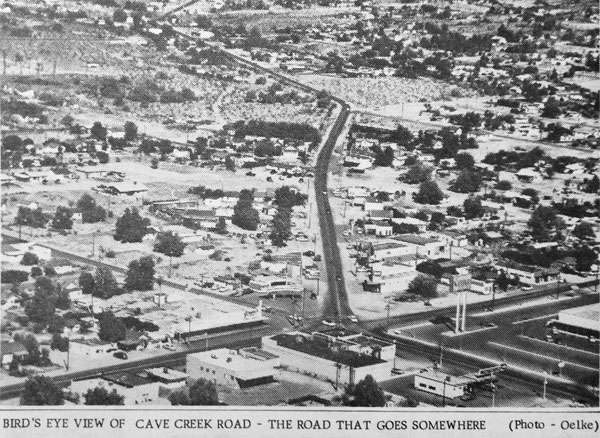 Sunnyslope played host to the 1957 Parade of Homes, with entrance marquee at 12th Avenue just south of Northern Avenue. Homeowners and prospective home buyers were treated to fourteen model homes by different valley builders all on one street, including contributions from Ralph Haver AIA, Ralph Staggs of Staggs-Bilt Homes, and prolific Valley legend John F. Long. The title of “The Southwest’s First Million Dollar Building Industries Exposition” was bestowed on the occasion that combined the 5th Annual Phoenix Home Show and the 1957 Parade of Homes. This showcase of homes represented the best in planning, design, and construction, as well as the latest in household appliances.
Sunnyslope played host to the 1957 Parade of Homes, with entrance marquee at 12th Avenue just south of Northern Avenue. Homeowners and prospective home buyers were treated to fourteen model homes by different valley builders all on one street, including contributions from Ralph Haver AIA, Ralph Staggs of Staggs-Bilt Homes, and prolific Valley legend John F. Long. The title of “The Southwest’s First Million Dollar Building Industries Exposition” was bestowed on the occasion that combined the 5th Annual Phoenix Home Show and the 1957 Parade of Homes. This showcase of homes represented the best in planning, design, and construction, as well as the latest in household appliances.
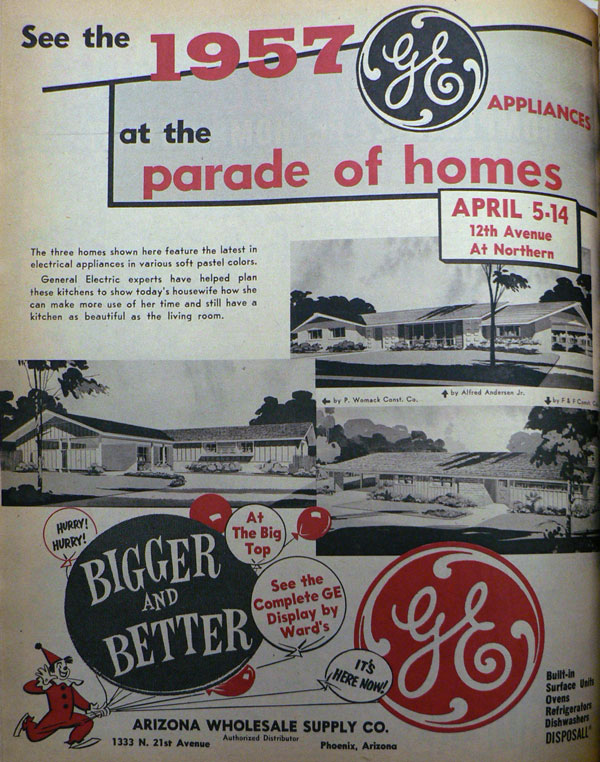 Sunnyslope was separated from Downtown Phoenix by seven miles. This distance allowed the community to independently develop its own unique identity. The valley was experiencing unprecedented growth, and cities like Phoenix were rapidly expanding. The annexation of Sunnyslope into the city of Phoenix was a battle forged over ten years, and the reality of the independent Town of Sunnyslope dissolved in 1959 when Sunnyslope was incorporated into the city of Phoenix.
Sunnyslope was separated from Downtown Phoenix by seven miles. This distance allowed the community to independently develop its own unique identity. The valley was experiencing unprecedented growth, and cities like Phoenix were rapidly expanding. The annexation of Sunnyslope into the city of Phoenix was a battle forged over ten years, and the reality of the independent Town of Sunnyslope dissolved in 1959 when Sunnyslope was incorporated into the city of Phoenix.
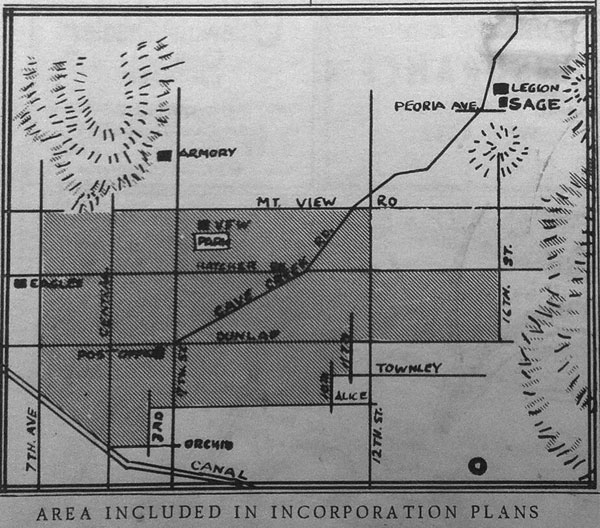 The community’s independent spirit is still visible today. Long before “green” was a buzzword, there were many examples in Sunnyslope. Don Dedera’s home is a prime specimen of preserving and bridging the past. Dedera was a columnist for the Arizona Republic, and later was Arizona Highways Editor-in-Chief. Don found a piece of Arizona history abandoned, and decided to purchase from the town of Mayer, a train depot which had been built in 1898. He had the depot brought from up north near Prescott to Sunnyslope, via a treacherous ride, to its new foundation as part of Dedera’s dream home. The blending was designed by noted Midcentury architect Fred Guirey, who designed a rare 1960‘s era entryway tower to integrate the depot to the home. Current owners, Will Auther and Allison Wiener fell in love with the 360 degree hilltop views. Today, after a well planned renovation the original ticket window divides the guest bedroom form the den.
The community’s independent spirit is still visible today. Long before “green” was a buzzword, there were many examples in Sunnyslope. Don Dedera’s home is a prime specimen of preserving and bridging the past. Dedera was a columnist for the Arizona Republic, and later was Arizona Highways Editor-in-Chief. Don found a piece of Arizona history abandoned, and decided to purchase from the town of Mayer, a train depot which had been built in 1898. He had the depot brought from up north near Prescott to Sunnyslope, via a treacherous ride, to its new foundation as part of Dedera’s dream home. The blending was designed by noted Midcentury architect Fred Guirey, who designed a rare 1960‘s era entryway tower to integrate the depot to the home. Current owners, Will Auther and Allison Wiener fell in love with the 360 degree hilltop views. Today, after a well planned renovation the original ticket window divides the guest bedroom form the den. 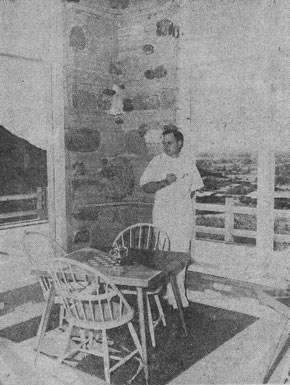
Dr. Hall enjoying the vista from North Mountain Hospital
The private North Mountain Hospital Hall built at 48 Foothill Drive no longer stands; however, the Hall's private residence completed in 1954 is still viewable on 2nd St. Both buildings were constructed using recycled materials from nearby demolitions. The hospital's common room and cafeteria's impressive floor-to-ceiling windows would have provided patients and guests with spectacular views from high above the city of Phoenix.

The Hall/Cash House in 2010
The Hall residence was hailed as an "up-to-tomorrow" structure. The house began as a standard issue tract home; but a growing family meant an expansion that grew over three separate construction periods. Drawing a line in the dirt with his toe, Hall would mark where a wall was to be erected. Even today the home still rambles over two lots. The first thing that would have drawn visitors' attention would have been the exterior fish pond that extended through a glass wall into the living room; this room included such modern features as a flagstone waterfall, and living areas for a large parrot and a myna bird. This is a good example of Hall's love of animals and plants that is seen throughout the house. Most of the rooms featured built-in planters, custom furniture, cabinets and even fireplaces. The house is currently undergoing a major renovation by the current owner, but has continued to improve the modern exterior.
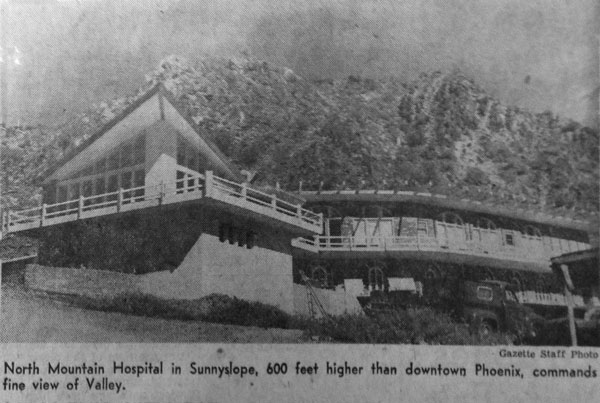 The relationship with Charles Cash continued from the Hospital, as he built much of the custom furniture as Wright tended to also do. Even hallway corners were utilized by including built-in couches and cabinets. The upstairs offered magnificent views of the valley and Piestewa Peak.
The relationship with Charles Cash continued from the Hospital, as he built much of the custom furniture as Wright tended to also do. Even hallway corners were utilized by including built-in couches and cabinets. The upstairs offered magnificent views of the valley and Piestewa Peak.
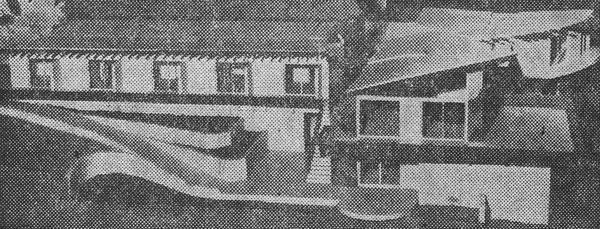
Scale model of the North Mountain Hospital
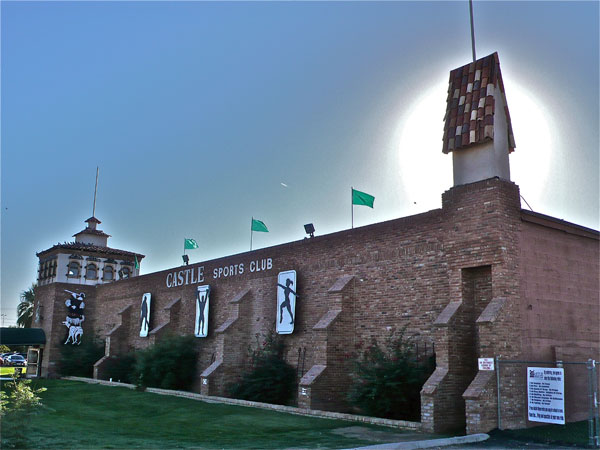
The old El Cid, now Castle Sports Club
Technically on the opposite side Sunnyslope's western boundary, Dr. Hall's story continues on the Northwest corner of 19th Ave and West Cholla Drive, which is currently the home of the Castle Sports Club. Dr. Hall originally built the structure and named it El Cid. The goal was to help meet the demand of a growing population's need of a recreation outlet. True to his nature, the building was built with many surplus materials. El Cid, built on 20 acres with more than 65,000 sq ft under one roof, included a thirty two lane bowling alley (up-cycled from a defunct Bowling alley in Mesa), an ice skating rink, four teenage recreation rooms and a snack bar. The facility was under construction for nearly twenty years and only opened for a year before bankruptcy struck. After that the building has served as a Pruitt's Furniture store and now a indoor hockey facility, which sometimes hosts a local roller derby.
The name El Cid comes from the epic 1961 Hollywood motion picture of the same name; a story about an 11th Century hero from Spain. The interior decor theme of space came from that time, but the exterior takes elements from a magazine picture of a Virginia Church. The Sports Club that inhabits the space still has many of the original features. Inside are 2 remaining hand carved doors and many wrought iron figures of men on horseback, coat of arms, and suits of armor. All the art work is the hand of immigrant artist, William Heguigorri, who was in Arizona for the health of his wife. Heguigorri spent over two years on the details of 20 hand carved doors, and created the art work inset into the interior arches. One of the most striking features is that each steel girder has been covered with a plastic/ cement mixture that is scored to mimic Ponderosa pine bark and lines a large terrazzo walkway with hand set images throughout.
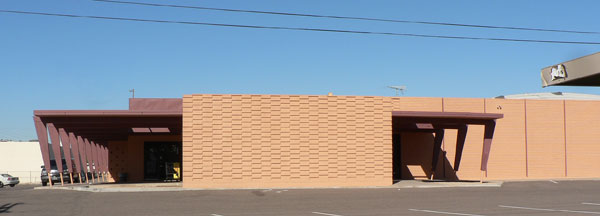
Northgate / Sunset / Let It Roll Bowling Alley
On the subject of striking bowling alleys, Let it Roll Bowl is a 32-lane bowling alley at 12th Street and Dunlap that was opened in the early 1960’s as the Northgate Bowl. This building was designed by Architects Pierson and Miller AIA who shared space with other creatives in Ralph Haver’s office complex on Missouri. The influence of Haver’s style is clearly evident in the angled wood posts held together with industrial fittings, skylight feature near the shaded Restaurant entrance, and general proportions of the block structure. Though the nature of the Haver & Nunn/Pierson & Miller relationship is yet a mystery, the alley still stands mostly intact as originally constructed.
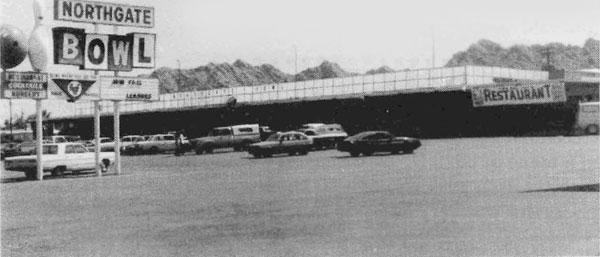
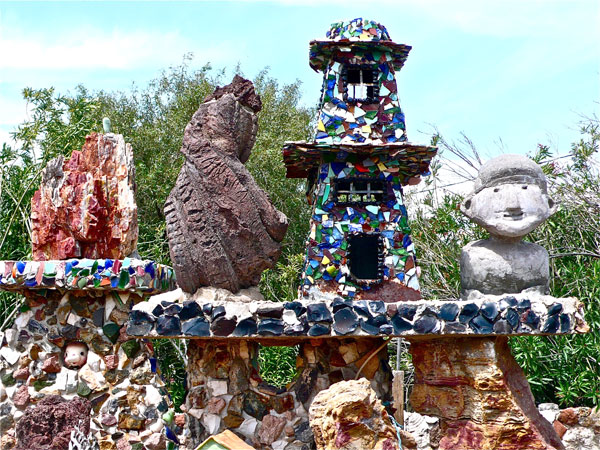
Thompson Rock Garden
There are many examples of creative individuals such as artists residing in Sunnyslope. One of the most unusual would be the work of Grover Cleveland Thompson, who was the builder of the Thompson Rock Garden. Thompson was heavily influenced by the Peterson Rock Garden in his former Oregon neighborhood. Thompson spent twenty years creating his prior world in his front yard from concrete, Fiesta china, and anything else that he could incorporate into his sculptures. There‘s a nine foot tall space needle, a rendering of the first house he lived in, and many concrete busts dressed in hats, sunglasses and jewelry. The Smithsonian American Art Museum has documented and cataloged this amazing folk art creation. The current owner, caretaker, and resident artist Marion Blake has been opening the garden on a regular basis to share the art with the community.

Over the Rainbow: Building Material Museum
Just North of Sunnyslope, but too quirky to leave out is the amazing site of Over the Rainbow: Building Material Museum. Gus Brethaue wanted the folk artist Thompson to build on the land that Gus’s family purchased in Sept 1929. The purchase was locally famous since his family bought at the height of the market, with a depression to soon follow. Gus has collected building debris far and wide to repurpose into an outdoor walking extravaganza filled with many artifacts such as a barbed wire collection, a medallion from the exterior of the Downtown Phoenix’s glamorous ( demolished) Fox Theater, and bricks from various iconic buildings repurposed into planters containing crested saguaro cacti. A simple planter was not enough, so statues of a sphinx were added or transformed into a bear or triceratops lurking behind a boulder ready to scare visitors.

Hilltop Apartments by Glenn Schauer
To capitalize on the unparalleled scenery viewable from the mountain, a 16 unit apartment building on the 1100 block of East Butler Drive was built high on a hill. The bottom level are garages, the second floors are living room and kitchens, with the third and top floor featuring bedrooms with great views. The architect Glenn Schauer mentioned that getting water up hill was a challenge. Yet another challenge is getting an automobile up the steep and narrow driveway to the garage – it’s not a task for the faint of heart.
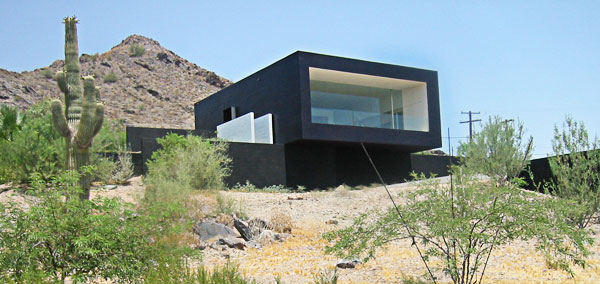
The Dialog House by Wendell Burnette in 2003
100 years later Sunnyslope is still a community that continues to develop its own unique flavor. It is currently home to of some of the best Mexican cuisine from Oaxacan region, and sustains a sizable number of creatives that include architects, artist, fabric designers, interior designers and musicians. A new generation of individuals seeking the freedom of expression and tolerance for difference has settled in the area, making Sunnyslope Arizona one of the most intriguing midcentury neighborhoods of all time.
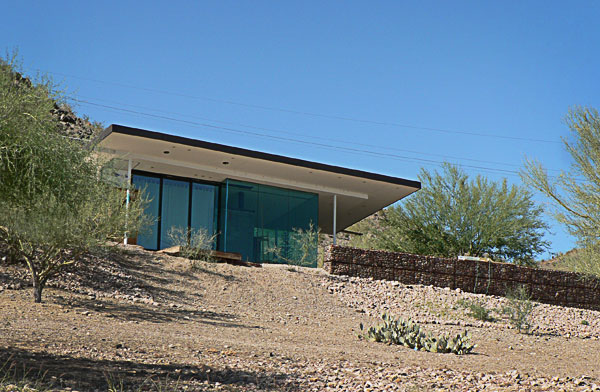
The Trahan Residence in 2010
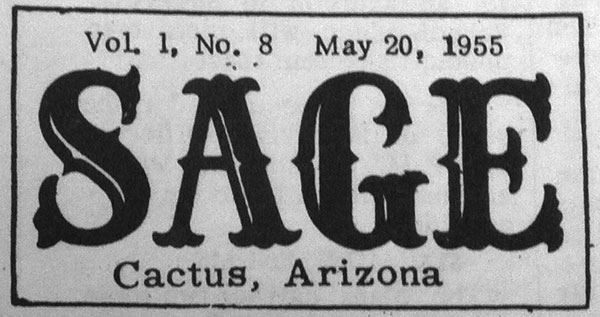
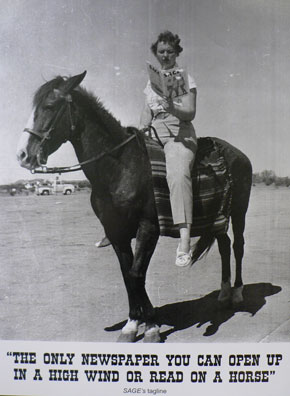
Marshall Shore has been a librarian for twenty years and is preserving Arizona history through Marshall Shore: Retro Spectacular, a live presentation celebrating unique people and architecture in a theatrical blend of images and storytelling. Now in it's second season, the show has been named one of the Best of Phoenix 2010 by Phoenix New Times. To inquire about booking a performance contact him at marshallshore-at-gmail.com or follow his adventures: Blog - FoundAZ.com Facebook - Marshall Shore: Retro Spectacular Twitter @retroAZ